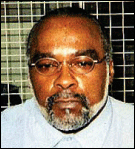Driving back to the East Bay from San Quentin Prison at 1:30 a.m., I'm nauseated. I just spent the last five hours with 2,500 people participating in a peaceful vigil for Stanley "Tookie" Williams. The steel slits of the Richmond-San Rafael Bridge animate the image of the dark San Francisco Bay below like a zoetrope. One of the seventeen media witnesses to the execution is on the radio. He talks about how the first needle easily slid into Tookie's arm, but how the second needle took over ten minutes to lodge properly in Tookie's other arm. The reporter meticulously recounts Tookie's protracted last minutes: a female voice shouted the death warrant, translucent chemicals pumped into Tookie's veins, his head arched up, his fist in Black Power, his head down, his repose.
I grimace, remembering the speaker at the protest outside the prison gates saying, at midnight, that sometimes lethal injections take fifteen or twenty minutes to kill a person, and that we should all be calm and prayerful during that time. The reporter on the radio continues detailing the execution: the motionless people around him, the thickness of the glass that separated the execution chamber from the thirty-nine execution witnesses. How it all resembled "a normal medical procedure." I can't listen any longer.
The reporter's comparison of the execution to a medical procedure reminds me of how Americans are anesthesitized to violence today. Our society focuses on the meaningless details: how many cc's of heart-attack-inducing drugs were pumped into Tookie, how many minutes he took to die, the ages of his victims, where he shot them, etc.
We must instead take a wider viewpoint and look at crimes and acts of violence within their larger context. More-productive questions to ask are: Why is this violence occurring? What's its origin, and how can we stop it? It is hypocritical of California to lend itself to the evil it condemns: murder. Capital punishment is antithetical to the goal of reducing violence because as Gandhi says, "violence only begets more violence."
A heavy burden weighs upon my conscience knowing that a small percentage of my tax dollars went to buy the needle to kill a five-time Nobel Peace Prize nominee. I know that abolishing the death penalty will be one more step toward stopping the cycle of violence, as Tookie tried to do with his redemptive 180 degree turn away from gang violence and toward youth outreach. Let us hope that Tookie and Clarence Ray Allen's are the final deaths our tax dollars support. On February 21, 2006, U.S. District Judge Jeremy Fogel imposed a temporary moratorium on executions in California. He ordered two anesthesiologists to be present at the execution of Michael Angelo Morales, however in the final hours before Morales's execution, the anesthesiologists refused to be present during the execution because of ethical reasons. Morales's execution is postponed until a May 2 and 3 hearing determines the constitutionality of the lethal injection procedure used in California since 1996.
By harnessing the power of noncooperation (through their refusal to participate in death) and nonviolent principle (the Hippocratic Oath "to do no harm") these doctors stand as a roadblock to capital punishment. Also, citizen action spearheaded by people like Sister Helen Prejean can awaken people to the structural violence in America, and the violence conducted in their names; and prompt people to take action and demand capital punishment be outlawed.
Attending the executions of Tookie Williams, Clarence Ray Allen, and Michael Morales at San Quentin, I have seen people radically transform the pain they've felt standing helpless outside, into a compassionate power that motivates them to campaign day after day against the death penalty. Seeing this nonviolent protest in the face of state-sponsored violence elevated my commitment against the death penalty. Standing in the vigils, holding candles into the morning hours, I saw people transform themselves into "the dancing flames committed to conquering darkness." Let us hope those are our last midnight visits to the gates of San Quentin.


